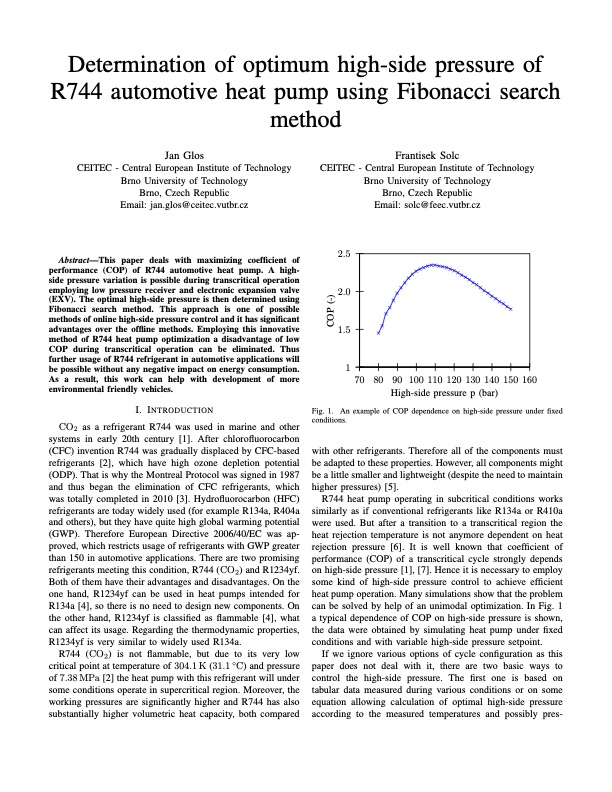
PDF Publication Title:
Text from PDF Page: 002
Determination of optimum high-side pressure of R744 automotive heat pump using Fibonacci search method Jan Glos CEITEC - Central European Institute of Technology Brno University of Technology Brno, Czech Republic Email: jan.glos@ceitec.vutbr.cz Abstract—This paper deals with maximizing coefficient of performance (COP) of R744 automotive heat pump. A high- side pressure variation is possible during transcritical operation employing low pressure receiver and electronic expansion valve (EXV). The optimal high-side pressure is then determined using Fibonacci search method. This approach is one of possible methods of online high-side pressure control and it has significant advantages over the offline methods. Employing this innovative method of R744 heat pump optimization a disadvantage of low COP during transcritical operation can be eliminated. Thus further usage of R744 refrigerant in automotive applications will be possible without any negative impact on energy consumption. As a result, this work can help with development of more environmental friendly vehicles. I. INTRODUCTION CO2 as a refrigerant R744 was used in marine and other systems in early 20th century [1]. After chlorofluorocarbon (CFC) invention R744 was gradually displaced by CFC-based refrigerants [2], which have high ozone depletion potential (ODP). That is why the Montreal Protocol was signed in 1987 and thus began the elimination of CFC refrigerants, which was totally completed in 2010 [3]. Hydrofluorocarbon (HFC) refrigerants are today widely used (for example R134a, R404a and others), but they have quite high global warming potential (GWP). Therefore European Directive 2006/40/EC was ap- proved, which restricts usage of refrigerants with GWP greater than 150 in automotive applications. There are two promising refrigerants meeting this condition, R744 (CO2) and R1234yf. Both of them have their advantages and disadvantages. On the one hand, R1234yf can be used in heat pumps intended for R134a [4], so there is no need to design new components. On the other hand, R1234yf is classified as flammable [4], what can affect its usage. Regarding the thermodynamic properties, R1234yf is very similar to widely used R134a. R744 (CO2) is not flammable, but due to its very low critical point at temperature of 304.1 K (31.1 ◦C) and pressure of 7.38 MPa [2] the heat pump with this refrigerant will under some conditions operate in supercritical region. Moreover, the working pressures are significantly higher and R744 has also substantially higher volumetric heat capacity, both compared Frantisek Solc CEITEC - Central European Institute of Technology Brno University of Technology Brno, Czech Republic Email: solc@feec.vutbr.cz 2.5 2.0 1.5 1 ×××××××××××××××××××××××××××××××××× × × 70 80 90 100 110 120 130 140 150 160 High-side pressure p (bar) Fig. 1. An example of COP dependence on high-side pressure under fixed conditions. with other refrigerants. Therefore all of the components must be adapted to these properties. However, all components might be a little smaller and lightweight (despite the need to maintain higher pressures) [5]. R744 heat pump operating in subcritical conditions works similarly as if conventional refrigerants like R134a or R410a were used. But after a transition to a transcritical region the heat rejection temperature is not anymore dependent on heat rejection pressure [6]. It is well known that coefficient of performance (COP) of a transcritical cycle strongly depends on high-side pressure [1], [7]. Hence it is necessary to employ some kind of high-side pressure control to achieve efficient heat pump operation. Many simulations show that the problem can be solved by help of an unimodal optimization. In Fig. 1 a typical dependence of COP on high-side pressure is shown, the data were obtained by simulating heat pump under fixed conditions and with variable high-side pressure setpoint. If we ignore various options of cycle configuration as this paper does not deal with it, there are two basic ways to control the high-side pressure. The first one is based on tabular data measured during various conditions or on some equation allowing calculation of optimal high-side pressure according to the measured temperatures and possibly pres- COP (-)PDF Image | high-side pressure of R744 automotive heat pump using Fibonacci search

PDF Search Title:
high-side pressure of R744 automotive heat pump using Fibonacci searchOriginal File Name Searched:
2017_ISIE_R744_Fibonacci.pdfDIY PDF Search: Google It | Yahoo | Bing
CO2 Organic Rankine Cycle Experimenter Platform The supercritical CO2 phase change system is both a heat pump and organic rankine cycle which can be used for those purposes and as a supercritical extractor for advanced subcritical and supercritical extraction technology. Uses include producing nanoparticles, precious metal CO2 extraction, lithium battery recycling, and other applications... More Info
Heat Pumps CO2 ORC Heat Pump System Platform More Info
| CONTACT TEL: 608-238-6001 Email: greg@infinityturbine.com | RSS | AMP |